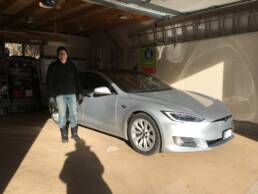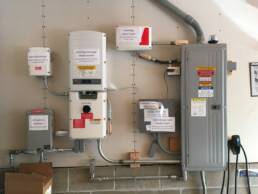
Photo above: Jukka Kukkonen’s Model S was ready for a test ride, charged with solar power.
The transition to electrified transportation is well underway and accelerating. In January, I had the opportunity to discuss transportation electrification impacts with Jukka Kukkonen during a trip to my home state of Minnesota.
Kukkonen is an automotive engineer and the owner and operator of PlugInConnect, a consultancy firm specialized in electric vehicles (EVs). Kukkonen advocates for a transition to electrified transportation. Through his firm, Kukkonen provides information and education about EVs to electric utilities, car dealerships, policymakers, and others interested.
During an afternoon of conversation at Kukkonen’s home, I learned about some positive and surprising impacts created and enabled by EVs. I also had the thrill of test driving Kukkonen’s Tesla Model S, a heart pumping experience.
Looking at transportation electrification through an impact assessment and life cycle assessment lens helps to understand the bigger picture and areas needing attention.
Type of energy production for EVs is crucial
In a world facing the dangers of global warming, one of the most significant remedies promised by EVs is lower greenhouse gas (GHG) emissions.
Often marketed as zero-emission vehicles, it is true that EVs can be operated with fewer GHG emissions than conventional internal combustion engine vehicles (ICEVs). This is partly because electric vehicles are more efficient than ICEVs at converting energy into movement.
The potential emissions reduction depends greatly on how the electricity used to power the EV is produced. As Kukkonen’s home is equipped with solar panels and battery storage units, he can often charge his EV without producing any GHG emissions.
CarbonCounter calculates GHG emissions
In 2015, the Union of Concerned Scientists (UCS) found that in the United States, EVs produce half the GHG emissions of average comparable ICEVs.
The findings of UCS were based on a life cycle assessment, which included consideration of the emissions produced from battery manufacturing.
In a report published in 2018, the European Environment Agency (EEA) found that a typical EV will also produce fewer GHG emissions in Europe than its equivalent ICEV. The EEA report was also based on a life cycle assessment.
According to Fingrid, producing the energy needed to move an electric car in the Nordpool area causes fewer CO2 emissions than producing the petroleum needed to move a new low-emission gasoline or diesel car alone (EV: 19 g/km; ICEV: 23 g/km).
In Fingrid’s comparison, once in use, a new low-emission ICEV will cause a further 119 g/km of CO2emissions. While the emissions created while producing both petroleum and electricity are subject to the EU Emissions Trading System, the additional in-use CO2 emissions created by ICEVs are not.
To reveal life cycle cost and GHG emissions (gCO2eq/km) for 125 different cars in the US, the Massachusetts Institute of Technology has developed “CarbonCounter”, a GHG emission and cost calculator.
According to the CarbonCounter, even if Kukkonen charges from the grid, his EV will still cause fewer emissions than most ICEVs, based on US Midwest electricity emission levels.
A tool like the CarbonCounter for the Finnish (and European) market would be helpful for comparing the life cycle cost and GHG emissions of different vehicles based on energy source and driving patterns.

Photo above: Solar panels on Kukkonen’s home and garage produce electricity for household needs, car charging, and sometimes even selling back to the grid.
Significantly improved air quality requires reduced vehicle use
The promise of reduced local emissions is an attractive one in cities, where pollution from cars is an especially serious problem.
ICEV exhaust emissions, containing nitrous oxides (NOx) and particulate matter, degrade local air quality and are harmful to human health. Pollution from cars, however, is not solely limited to combustion.
Tires, road surface wear, resuspension of road surface dusts, and brake wear cause particulate matter that must also be considered.
EVs are typically equipped with regenerative braking systems, reducing brake wear impacts. However, there are still uncertainties surrounding particulate matter emissions and overall impacts on local air quality.
In order to seriously reduce pollution levels in cities, the overall amount of vehicle use should be reduced. Instead, public transit, walking, and biking should be encouraged.
Comparison requires life cycle analysis
The batteries and drivetrains used in EVs require raw materials not needed in conventional ICEVs. Mining and processing these materials, such as cobalt, graphite, and lithium, creates certain environmental and social impacts unique to EVs.
Mining of raw materials can be environmentally destructive and can fuel conflict, as has been seen in the Democratic Republic of the Congo.
At the same time, extracting, shipping, and refining petroleum for use in ICEVs also results in myriad environmental and social impacts which should be considered.
A life cycle assessment of petroleum would be helpful in this comparison, considering these various impacts.
Lack of data and methodology in comparison
To better understand environmental impacts from producing the batteries and drivetrains needed in EVs, I discussed the topic with Dr. Roland Gauß, Senior Advisor on Substitution and Recycling at EIT Raw Materials.
According to Dr. Gauß, it is still very difficult to measure these impacts, due to a lack of data and methodology problems.
There is poor data regarding raw materials, and even companies using the raw materials might not know their history.
To determine the sustainability of an EV, a close look at what kind of raw materials are used is needed.
Dr. Gauß explained that there is a lack of transparency in the value chains for the raw materials.
It is possible to achieve overall greater sustainability with EVs compared to ICEVs, but more attention is needed on the value chain of EV raw materials to get there and impacts created along the way need to be addressed.
Standardization and certification of these raw materials could help the situation.
Battery raw materials need recycling
If raw materials will be extracted, it seems a case can be made for tightly regulated Finnish or European production, rather than sourcing that shifts greenhouse gas emissions and social and environmental impacts abroad.
Mining processes must be improved, though, to further minimize negative externalities and gain social license to operate.
Once materials are extracted, products containing them could be considered a material bank. To enter a sustainable circular economy, it is essential to improve solutions to effectively and efficiently reuse or recycle the valuable materials contained by EV batteries and drivetrains.
Components should also be designed in a way that enables reuse and recycling. Policymakers can affect this through laws requiring recyclability and reuse.
EVs may boost local economies
Electric vehicles can also produce surprising impacts. In general, EVs are cheaper to operate than ICEVs.
Depending on the purchase price, this can make an EV a cheaper form of transportation than an ICEV, leaving consumers with more money to save or spend elsewhere.
These savings can potentially provide a boost to local economies.
Additionally, the purchase of local energy rather than imported petroleum for transportation can also potentially boost local economies.
The large batteries carried by EVs can be used as a buffer and flexible load for electricity. This could help solve the challenge of storing peak production for later use in a grid with more renewable and varying energy production.
At the end of an electric vehicle’s life, the batteries can also be repurposed for local or domestic energy storage.

Photo above: Kukkonen’s garage wall has a variety of electrical equipment to manage the energy flow of solar panels, storage batteries, and chargers. Everything was well-marked to show visitors.
Policy has a significant impact
The potential influence of policymakers and the public sector in shaping the transition to electrified transportation is significant.
A host of Norwegian state incentives have enabled the rapid adoption of electric vehicles in Norway. In a country where nearly all energy comes from renewable sources, a progressive tax system and “polluter pays” principle makes electric vehicles cheaper than similar petrol models.
Norwegian motorists have responded to the incentives; in March of this year, more than half of all new cars bought in Norway were fully electric.
The Norwegian Government has also been key in developing a comprehensive EV charging network throughout the country.
By 2017, Norway had launched a program to finance the development of rapid charging stations every 50 km on all main roads.
During a traineeship in 2017 at a small polytechnic university in Evenstad, a tiny village in one of the most sparsely populated areas of Norway, I was surprised to see a rapid car charging station on the school campus.
The university had also recently purchased an electric Nissan Leaf for student use, and projects to install solar panels throughout the campus have since been completed.
EVs create opportunities and challenges
Personal and widespread automobile use is still not sustainable, and might not ever be, even with widespread adoption of electric vehicles.
Significant emission and pollution reductions could more likely be met with efforts to improve and increase utilization of public transportation, bicycling, and walking.
Still, the transition to electrified transportation offers opportunities, but also comes with impacts that must be addressed.
The citizenry, policymakers, and industry all have an important role in making sure an electrified transportation future truly creates environmental, social, and economic benefits for all.
Principles and tools from impact assessment and life cycle assessment help to see the big picture and can reveal areas of potential concern. With this knowledge, an informed vision can guide development and a way forward to a greener world can be mapped.
Jack H. Raisanen
Environmental Planner
Member of the Board of FAIA (Yva ry) in 2018
Originally published in Impakti-lehti, a periodical from the Finnish Association for Impact Assessment (Yva ry).